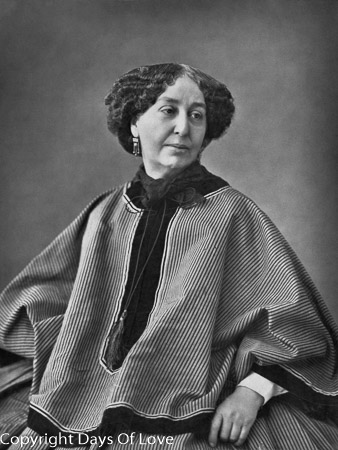

Partner Frédéric Chopin
Queer Places:
31 Rue de Seine, 75006 Paris, Francia
21 Quai des Grands Augustins, 75006 Paris
19 Quai Malaquais, 75006 Paris, France
20 Rue Jean-Baptiste Pigalle, 75009 Paris, France
Musée de la Vie Romantique, 16 Rue Chaptal, 75009 Paris, France
5 Sq. d'Orléans, 75009 Paris, France
5 Rue Gay-Lussac, 75005 Paris, Francia
Le Bourg, 36190 Gargilesse-Dampierre, Francia
2 Place Saint Anne, 36400 Nohant-Vic, Francia
 Amantine
Lucile Aurore Dupin[1]
(1 July 1804 – 8 June 1876), best known by her nom de plume George
Sand, was a French novelist and memoirist. She is equally well known for her
much publicized romantic affairs with a number of artists, including the
composer and pianist Frédéric Chopin and the writer Alfred de Musset.
Amantine
Lucile Aurore Dupin[1]
(1 July 1804 – 8 June 1876), best known by her nom de plume George
Sand, was a French novelist and memoirist. She is equally well known for her
much publicized romantic affairs with a number of artists, including the
composer and pianist Frédéric Chopin and the writer Alfred de Musset.
Sand wrote: "My name is not Marie-Aurore de Saxe, Marquise of Dudevant, as several of my biographers have asserted, but Amantine-Lucile-Aurore Dupin, and my husband, M. François Dudevant, claims no title: the highest rank he ever reached was that of infantry second lieutenant."[2]
Always known simply as "Aurore",[3] she was born in Paris, but raised for much of her childhood by her grandmother, Marie-Aurore de Saxe, Madame Dupin de Francueil, at her grandmother's estate, Nohant, in the French province of Berry. Sand later used the setting in many of her novels. Her upbringing was quite liberal. Her father, Maurice Dupin, was the grandson of the Marshal General of France, Maurice, Comte de Saxe, an illegitimate son of Augustus II the Strong, King of Poland and a Saxon elector, and a cousin to the sixth degree to Kings Louis XVI, Louis XVIII and Charles X of France.[4] She was also related much more distantly to King Louis Philippe of France through common ancestors from German and Danish ruling families. Sand's mother, Sophie-Victoire Delaborde, however, was a commoner.
In 1822, at the age of eighteen, Sand married Casimir Dudevant (1795–1871; first name "François"), illegitimate son of Baron Jean-François Dudevant. She and Dudevant had two children: Maurice (1823–1889) and Solange (1828–1899). In early 1831, she left her husband and entered upon a four- or five-year period of "romantic rebellion." In 1835, she was legally separated from Dudevant and took her children with her.
Sand conducted affairs of varying duration with Jules Sandeau (1831), Prosper Mérimée, Alfred de Musset (summer 1833 – March 1835), Louis-Chrysostome Michel, Pierre-François Bocage, Charles Didier, Félicien Mallefille, Louis Blanc, and Frédéric Chopin (1837–1847).[5] Later in life, she corresponded with Gustave Flaubert, and despite their differences in temperament and aesthetic preference, they eventually became close friends. She engaged in an intimate friendship with actress Marie Dorval, which led to widespread but unconfirmed rumours of a lesbian affair.[6] Letters written by Sand to Dorval made such references as "wanting you either in your dressing room or in your bed".
In Majorca one can still visit the (formerly abandoned) Carthusian monastery of Valldemossa, where she spent the winter of 1838–1839 with Chopin and her children.[7] This trip to Majorca was described by her in Un hiver à Majorque (A Winter in Majorca), first published in 1841.[8] Chopin was already ill with incipient tuberculosis (or, as has recently been suggested, cystic fibrosis) at the beginning of their relationship, and spending a winter in Majorca — where Sand and Chopin did not realize that winter was a time of rain and cold and where they could not get proper lodgings—exacerbated his symptoms.[9] They separated two years before his death for a variety of reasons. In her novel Lucrezia Floriani, Sand used Chopin as a model for a sickly Eastern European prince named Karol. He is cared for by a middle-aged actress past her prime, Lucrezia, who suffers a great deal through her affection for Karol.[10] Though Sand claimed not to have made a cartoon out of Chopin, the book's publication and widespread readership may have exacerbated their antipathy to each other. The tipping point in their relationship involved her daughter Solange.
Chopin continued to be cordial to Solange after she and her husband, Auguste Clésinger, had a vicious falling out with Sand over money. Sand took Chopin's support of Solange as outright treachery and confirmation that Chopin had always "loved" Solange.[11] Sand's son Maurice also disliked Chopin. Maurice wanted to establish himself as the "man of the estate" and did not wish to have Chopin as a rival. Chopin was never asked back to Nohant; in 1848, he returned to Paris from a tour of the United Kingdom, to die at the Place Vendôme in the following year. Chopin was penniless at that time; his friends had to pay for his stay there, as well as his funeral at the Madeleine. The funeral was attended by over 3,000 people, including Eugène Delacroix, Franz Liszt, Victor Hugo and other famous people. George Sand was notable by her absence.
Sand was also known for her implication and writings during the Paris Commune, where she took a position for the Versailles assembly against the "communards", urging them to take violent action against the "rebels".[12]
George Sand died at Nohant, near Châteauroux, in France's Indre département on 8 June 1876, at the age of 71 and was buried in the private graveyard behind the chapel at Nohant-Vic.[17] In 2003, plans that her remains be moved to the Panthéon in Paris resulted in controversy.[18][19]
My published books: